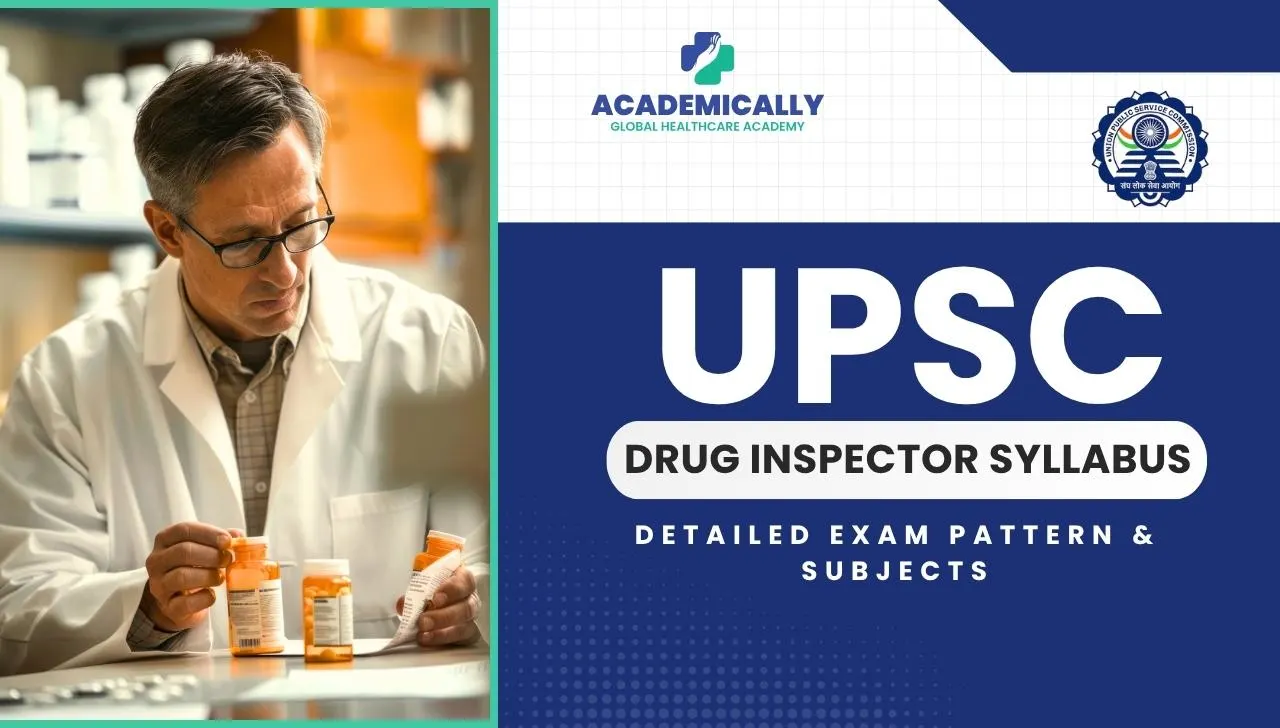A Drug Inspector is perhaps one of the most interesting jobs out there. It has a bit of everything: Skill, integrity and adventure. You would need to clear the UPSC Drug Inspector exam before you can become one. And the first step to clear the exam is to understand the exam syllabus and pattern. The syllabus tells you what to study and how to study for a successful attempt.
In this blog, we’ll unpack the syllabus for UPSC Drug Inspector 2026. We will walk through the exam pattern. You will also know different ways to turn this blueprint into a winning strategy.
UPSC Drug Inspector 2026- The Official Framework
Notification and Recruitment Test in 2025
Here is the pattern for the UPSC’s 2025 Drug Inspector recruitment (Medical Devices) Recruitment Test:
- Date & Time: 02 November 2025, 09:30 AM to 11:30 AM
- Duration: 2 hours
- Marks: 300
- Question Type: Objective (Multiple Choice)
- Language: English
- Marking: 2.5 for correct answer. 1/3 deduction for every wrong answer. No penalty if unattempted.
- Weightage: RT and Interview in a 75:25 ratio
We can assume that the 2026 exam will carry a similar structure unless the official notification says otherwise.
What This Means for You
- Speed and Accuracy matter: 300 marks in 120 minutes means an average of 0.4 minutes per mark.
- Negative marking: Guessing carries risk.
- Syllabus breadth: You can’t wing large topics.
- Interview matters: 25% weight means even after RT. Your personality stage counts.
UPSC Drug Inspector Syllabus: What Areas to Cover
Based on the official syllabus, the content is well-defined. Below is a consolidated and structured syllabus list you should use for 2026.
| Subject Area | Topics | Notes / Tips |
| Pharmaceutical Chemistry | Chemistry of drugs Uses Mechanisms Chemical classes Structure–activity relationships | Make tables of Drug classes Functional groups Metabolic pathways |
| Manufacturing & Dosage Forms | Tablets Coatings Capsules Emulsions Suspensions Ointments Creams Parenterals Biologicals (vaccines, sera, antisera) | Draw manufacturing flowcharts Understand QC checkpoints |
| Pharmaceutical Analysis | Limit tests Bioassays Sterility and pyrogen tests, Spectrophotometry Titrimetry Microbiological assays Colorimetry Turbidimetry | Emphasize methodologies and calculations |
| Medicinal Chemistry | Storage Structure Brand names of steroids Analgesics Sedatives Antihistamines Cardiovascular drugs | Flashcards help retention of brand and generic mapping |
| Pharmacognosy / Natural Products | Sources and uses Adulteration of medicinal plants | Morphology Active constituents Adulteration tests |
| Pharmacology & Toxicology | Drug-receptor interactions Metabolism Antagonism Adverse reactions Toxicity ADME Profile | Pay attention to Dose and toxicity curves Adverse effect mechanisms |
| Hospital & Clinical Pharmacy | Prescription handling Incompatibilities Storage conditions Stability Clinical dispensing principles | Go through sample prescriptions and case studies |
| Anatomy, Physiology & Health Education | Body systems First aid Population control Public health basics | Solidify fundamentals from first-year pharmacy |
| Regulatory & Legal Framework | Drugs & Cosmetics Act Good Manufacturing Practices (GMP) Good Laboratory Practices Good Clinical Practices Medical Devices Rules | This is crucial. Many questions are asked verbatim from statutes. |
| Biopharmaceutics and Pharmacokinetics | Absorption Bioavailability Half-life Volume of distribution Clearance Kinetics models | Practice numerical problems |
| Investigational Skills | Sample collection Assay planning Statistical thinking Methodology design | Connect theory to practice |
| Computer Applications & English Proficiency | Basic computer operations MS Office Data handling Comprehension and grammar | These serve to score more marks when the technical subject is heavy |
Note that the 2025 notification adds a few general and non-technical topics in the RT syllabus:
- Current issues- national and international
- Reasoning and quantitative aptitude
- General science
The 2026 exam might mix technical and general aptitude content.
Exam Pattern & Strategy for 2026
Pattern Snapshot
| Parameter | Detail |
| Duration | 2 hours |
| Total Marks | 300 |
| Question Type | Objective - MCQ |
| Negative Marking | -1/3 for wrong answers |
| Language | English |
| Weightage RT: Interview | 75:25:00 |
| Minimum qualifying standards | General ≥ 50 marks OBC ≥ 45 SC/ST ≥ 40 |
How to Read This Pattern Smartly
- Every question has equal weight. No sectional weighting is publicly mentioned in the 2025 addendum.
- You must cover all topics. Make sure to practice numerical as well as drug mechanisms.
- Since negative marking is active, strategic guessing is risky. Better leave if unsure
- The general aptitude and reasoning section, along with the current affairs and science chunk, may act as a scoring opportunity if technical questions turn tough.
Sample Interactive Checkpoints- Self-Quiz
Let’s pause for a quick self-check to make your reading active:
- Which Act governs the sale/import of drugs in India, and may be asked as a legal question?
- True / False: The 2025 RT allowed both English and Hindi as media.
- Which of these topics would belong to Pharmaceutical Analysis?
a) Parenteral preparation
b) Sterility test
c) Distribution of drugs in tissues
d) Prescription handling
Turning Syllabus into a 2026 Study Plan
Phase 1: Broad Coverage + Gap Analysis (Months 1–3)
- Spread out all major subjects (Pharma chem, manufacturing, analysis) across weekly slots
- Maintain short summaries (1–2 pages) per topic
- After each week, do a mini-quiz (20 mcq) on that content
Phase 2: Deep Dive + Interlinking (Months 4–6)
- Solve previous year questions
- Integrate law and practice.
- Tie regulations to drug examples
- Practice quantitative, reasoning and current affairs sections
- Work on time-bound mock tests for full 2 hours
Phase 3: Revision & Mock Tests (Last 1–2 months)
- Frequent full-length mocks under strict exam conditions
- Revision of weak topics.
- Use flashcards for drug names and regulations
- Improve test-taking strategy
Self-Quiz Answers and Reflection
- Which Act? Drugs & Cosmetics Act, 1940
- True / False: False, 2025 RT uses English only
- The sterility test belongs to Pharmaceutical Analysis
If you got less than 60% correct, highlight those sections and revisit.
Common Mistakes and Tips to Avoid Them
- Ignoring Regulatory Acts & Rules: Many candidates stumble here.
- Overemphasis on one subject at the cost of others.
- Not practising the negative marking strategy: It’s better to skip than guess blindly.
- Underestimating the general science and aptitude section.
- Neglecting the interview and personality stage: Polish your soft skills and current affairs.
Checklist Before UPSC 2026 Drug Inspector Exam
- Thoroughly revised summaries and formula sheets
- Practice at least 10 full mocks in exam-like settings
- Revise legal part like Drugs & Cosmetics Act, Medical Devices Rules
- Ratio of correct vs attempted questions calibrated
- Confidence in thinking on your feet during interview
Next Steps
The syllabus and pattern for 2026 will certainly echo the 2025 framework, unless UPSC issues substantial changes. Treat the 2025 exam syllabus as your most reliable guide.
Start with a foundation phase. Then move to integration and practice. Finish with mock tests and revision. Use self-check quizzes to stay sharp and engaged. Most importantly, stay updated by watching for the official 2026 notification on the official UPSC site.
And if you want a fool-proof preparation plan, then we have got your back. Enrol into our UPSC Drug Inspector preparation course and start your journey to success.




